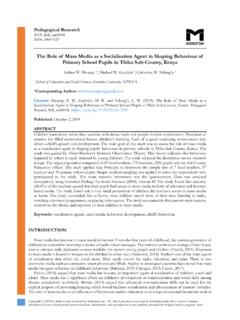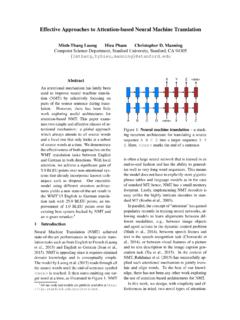Transcription of AGING OUT OF CRIME: EXPLORING THE RELATIONSHIP …
1 AGING OUT OF crime : EXPLORING THE RELATIONSHIP BETWEEN AGE AND crime WITH agent based MODELINGC aitlin V. M. CorneliusChristopher J. LynchVirginia Modeling, Analysis and Simulation CenterVirginia Modeling, Analysis and Simulation Center1030 University Boulevard, Suffolk, VA1030 University Boulevard, Suffolk, GoreVirginia Modeling, Analysis and Simulation Center1030 University Boulevard, Suffolk, have long observed a strong correlation between age and crime . The age crime RELATIONSHIP has withstood stringent testing since the 1920 s and repeatedly demonstrated that criminal activity peaks at age seventeen and then gradually declines. These efforts have resulted in the formation of several theories; however, quantitative assessment of these theories are incomplete and fail to fully examine the role of sociological and cultural factors.
2 In this paper, we create an agent - based model (ABM) that generates a society where individuals age out of a predisposition to commit crimes. We also extend the model into a tool for decision makers to gather actionable insight with respect to competing crime reduction policies. Our results demonstrate that modeling crime through an ABM enables decision makers to test the viability of crime -related policies by reducing the uncertainty associated with the potential crime reduction outcomes while examining the effectiveness of resource allocations. Keywords: agent - based modeling, criminology, resource allocation. 1 INTRODUCTION The RELATIONSHIP between age and crime is one of the most solid within the field of criminology. It is understood that crime increases throughout adolescence and then peaks at age 17 (slightly earlier for property crime than for violent crime ) and then begins to decrease over the life course moving forward.
3 This trend has, over the years, withstood stringent testing and examination across time periods and maintains consistent results regardless of race/ethnicity, education level, or income (see for example: Farrington 1986; Braithwaite 1989; Hirschi and Gottfredson 1983; Moffitt 1993; Piquero et al. 2003). Hirschi and Gottfredson (1983) are generally credited with the resurgence of criminology s examination of the age and crime RELATIONSHIP when they challenged this commonly held notion and suggested that the age and crime RELATIONSHIP was not as reliable as once thought and that the RELATIONSHIP was in serious need of reexamination. As recently as Shulman, Steinburg, and Piquero s (2013) very thorough testing however, criminologists have come to understand that it is necessary to also include sociological, psychological, and environmental elements into the understanding of the age and crime RELATIONSHIP .
4 6 SULQJ6LP $D6 $SULO 9 LUJLQLD %HDFK 9$ 86$ 6 RFLHW\ IRU 0 RGHOLQJ 6 LPXODWLRQ ,QWHUQDWLRQDO 6&6 Cornelius, Lynch, and Gore While criminology has traditionally utilized statistics as the basis of its science, there is perhaps another method of analysis well suited to the task, agent - based modeling. agent - based modeling is a computational method within the discipline of Modeling and Simulation (M&S) that allows the researcher to simulate reality in order to examine a phenomenon from an independent platform using the rules that govern that system (Bonabeau 2002; Epstein and Axtell 1996; Gilbert 2008; Gilbert and Terna 2000). The idea that computer simulations can present the researcher with a separate and unique source of data is appealing. When combined with the well-established quantitative and qualitative methods that social scientists are more used to, agent - based modeling could allow for a further triangulation of results, or possibly present the foundational point for new studies moving forward.
5 The current study applies agent - based modeling and criminology to better understand the age and crime RELATIONSHIP by simulating the manner in which an individual ages out of crime , or fails to. Previously, studies of this topic were limited to the available data in a given time or location. An ABM of the age and crime RELATIONSHIP allows researchers to examine how this RELATIONSHIP plays out over time, across multiple, simulated runs and potentially, with a larger population than previously examined. We hope the results will point specifically to a better understanding of how individuals proceed throughout life, how they advance or fall into criminality, and further, what elements of the environment can be manipulated in order to decrease the overall level of crime throughout the society.
6 2 THE AGE AND crime RELATIONSHIP The age and crime RELATIONSHIP is one of the strongest and most well tested in criminology. Starting with Farrington (1986), it is understood that rates of criminality generally increase through adolescence and peak at age 17 (again, slightly earlier for property crime than for violent crime ) and descend as the individual ages. While the observation of this phenomenon is reliable from a scientific standpoint, the natural question arises concerning what exactly is contributing to this decline over the life course. The possible explanations for why crime might decrease over an individual s lifetime can possibly be explained by already established criminological theories; specifically life course theory, social bond theory, strain theory, and social learning theory.
7 It is this integrated theory approach which has become the foundation for the construction of the current study s ABM. Sampson and Laub (2003) propose one possible theory with regard to the reduction of crime over the life course of an individual. Their general life course theory proposes that the individual ages out of crime due to the turning points that one encounters which sends them on a different trajectory. Sampson and Laub (2003) identify graduating from high school or college, serving in the military, getting married, purchasing property, or having children (among other examples) as turning points in life that directly alter one s trajectory. Further, these turning points can result in a trajectory away from criminality as crime is often not conducive to the achievement of each of these turning points.
8 For example, one who has children might veer away from criminality as one would not like to spend time in jail away from one s children nor have their children exposed to the dangers that often accompany criminal lifestyles. Sampson and Laub s life course theory, in the above sense, then begins to remind many criminologists of Travis Hirschi s (1969) social bond theory due to its specific explanation of how the turning points might directly lead to a decrease in criminality over time. Hirschi presents his ideas that there are four major components to one s RELATIONSHIP with society: attachment, commitment, involvement, and belief. He goes on further to explain these four elements: The attachment one has to their families and peers would lead to one not engaging in criminal behavior so as to not disappoint these individuals they hold in regard.
9 One s commitment to the dominating social norms and rules of law results in one s unwillingness to violate said norms and laws and therefore resist criminal behavior, lest the individual lose the investment they have made in society and their role within it. If an individual is involved then they simply are too busy to engage in criminal activity because they are otherwise engaged in the legitimate behaviors of maintaining a job or raising children. Lastly, the individual s belief that these rules and social norms are important and that violation will lead to unpleasant consequences will also lead to them avoiding criminal behavior (Hirschi 1969). Cornelius, Lynch, and Gore Agnew s (1992) strain theory also plays a role in the construction of the current study s ABM.
10 Strain theory states that crime is the natural result of the convergence of a few concepts; first, that our society imparts on the individual a need to obtain success in order to achieve status, second, the legitimate means of achieving that success are limited, third, those who are unable to achieve that success in a legitimate manner will resort to crime in order to keep status or as a means of objecting to the system. A classic example would be a felon who is not offered employment due to his felony status, commits robbery/burglary in order to afford to feed himself and his children. Strain theory is important in the construction of the current model in that it speaks to the connection between social status and crime and the criminality that can occur when one is denied legitimate means to obtaining social status.

![arXiv:1706.02275v4 [cs.LG] 14 Mar 2020](/cache/preview/f/5/a/8/3/f/c/2/thumb-f5a83fc2d66f1a4b47577f8358eaa6b6.jpg)


![arXiv:2201.08239v2 [cs.CL] 21 Jan 2022](/cache/preview/3/0/1/2/8/f/6/d/thumb-30128f6d5f9066d709b88d7dcf91951d.jpg)

